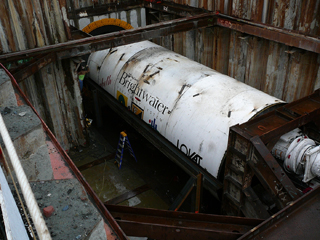|
Subscribe / Renew |
|
|
Contact Us |
|
| ► Subscribe to our Free Weekly Newsletter | |
| home | Welcome, sign in or click here to subscribe. | login |
Construction
| |
 |
August 30, 2012
With a bit of moxie, Brightwater tunnel finishes up
King County Executive

Constantine
|
Deep underground, for 13 miles between Woodinville and Puget Sound, King County has built and is nearly ready to open the conveyance tunnel that will make the Brightwater treatment system fully operational.
That’s roughly the distance between downtown Seattle and Sea-Tac Airport.
When it begins operating this fall, the conveyance tunnel will become one of the most important pieces of public works infrastructure built in our region since the 1960s. Engineered for a century of service, the deep-bore tunnel will use nothing more than gravity to carry highly treated wastewater from the state-of-the-art Brightwater plant to Point Wells and into Puget Sound through one of the world’s deepest municipal outfalls.
Along with the technologically advanced treatment plant that began operating last year, Brightwater’s tunnel will provide capacity in our regional wastewater system necessary to support economic growth, public health, and our natural environment for decades to come.
The tunnel was built in five separate segments by four joint-venture contractors using a project labor agreement that put hundreds of skilled tradespeople to work in family-wage jobs during a severe recession. Brightwater construction also employed apprentices through a program providing more training opportunities in skilled trades to women and minorities.
Construction began in October 2007 with the launch of “Luminita,” a 19-foot-diameter tunnel-boring machine that emerged successfully at the Brightwater Treatment Plant after its 14-month, 2.6-mile journey from Bothell. The 260-foot-deep tunnel holds separate pipelines carrying treated and untreated wastewater, as well as a “purple pipe” to deliver reclaimed water from Brightwater to customers in Bothell and the Sammamish Valley, including the Willows Run Golf Course.
Two additional tunnel-boring machines were launched from a construction shaft in Kenmore in 2007 to tunnel between Shoreline and Bothell. A fourth machine, “Elizabeth,” was launched from Point Wells in 2008 and successfully mined a 4-mile-long, 13-foot-diameter tunnel to Shoreline in 2009. This portion of the tunnel connects to a 600-foot-deep, mile-long outfall that will discharge Brightwater’s cleaned waters into Puget Sound.
Though Brightwater construction went exceptionally well overall, the tunnel’s path to completion was not exactly a straight line.
In 2009, mechanical problems sidelined the two machines building the critical central tunnels, jeopardizing the project’s schedule and budget.
It was my first week in office as County Executive when I was handed this serious problem to solve, one with no simple solution and no guaranteed outcome.
To protect the interests of King County and its regional wastewater utility ratepayers, I issued a declaration of emergency to waive procurement requirements and hired the contractor from the adjacent West Tunnel, Jay Dee/Coluccio (JDC), which already had its tunnel-boring machine “Elizabeth” in place. My decision replaced the contractor on the problematic section of one of the central tunnels and cleared the way for tunnel mining to resume from the opposite direction.
Skeptics questioned the plan and warned of technical challenges, possible delays and potential overruns. The story of the broken boring machine became a cautionary tale told by tunneling critics opposed to other deep-bore projects planned for the region. Some questioned whether Brightwater could even be completed as planned. After all, the tunnel is one of the longest ever built in the Pacific Northwest, with our hilly terrain, glaciated soils and high groundwater levels.
Given the level of investment, and Brightwater’s importance to regional economic and environmental health, failure was not an option. I called on the project team to press on, confident in the ability of the proven, newly hired contractor to succeed in mining the remaining 1.9 miles between Shoreline and Lake Forest Park.
The job required JDC and the boring-machine manufacturer to perform extensive modifications on “Elizabeth” to prepare it for geotechnical conditions and groundwater pressures that far exceeded original design capabilities. JDC resumed mining in September 2010.
Further complicating matters, “Elizabeth” was mining on a downward slope, putting the tunnel machine and its crew at risk from flooding. Crews installed redundant power and pumping systems above ground to ensure that underground water could be controlled.
Groundfreezing, already used at Brightwater’s Ballinger Way Portal, was relied upon to stabilize soils where the tunnels were to connect so “Elizabeth” could safely break through the area beneath Lake Forest Park, where the disabled boring machine had been cut apart and removed.
In August 2011, JDC’s crew sliced through the final sliver of earth 300 feet below ground, completing its mission more than a month ahead of schedule. Achieving this major milestone, and reaching it early, took careful planning and execution by the contractor and tough, high-stakes decision-making that maintained the momentum of the Brightwater project.
Unlike other big projects such as bridges or runways, the Brightwater tunnel will function entirely out of public view. However, the tunnel’s benefits will be visible to everyone for decades to come through a healthier Puget Sound, vibrant planned growth, and an economy that attracts new talent and investment.
Successful completion of the Brightwater tunnel shows how obstacles to progress can be overcome with a clear vision, a skilled and dedicated work force, engaged management and, when needed, a bit of moxie.
Thanks to this collaborative effort, we will deliver on the promise of wastewater capacity to protect our natural resources and support this region’s continued economic growth for generations to come.
Dow Constantine is King County Executive.
Other Stories:
- Biggest challenge? Maintaining what’s already built
- WSDOT warns statewide pavement at risk
- Artists turn the spotlight on infrastructure
- Record-breaking tunneling machine takes shape
- Puget Sound commuters ready for more light rail



